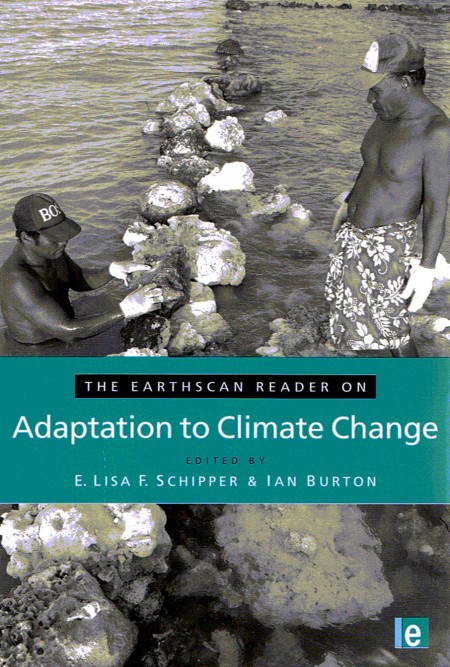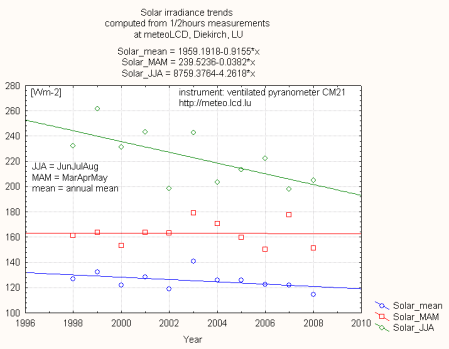
Similar to many of my colleagues I fell ill (with voice extinction and bronchitis) and had to stay in bed for 2 days: a good time to read the books left unread! So I went through the 458 pages thick Earthscan Reader on “Adaptation to Climate Change” (2009, ISBN 978-84407-530-0) by E.L.F. Schipper and I. Burton, editors. I was prepared for the worst, but this did not happen. The book is a compilation of papers and articles written for most of them prior to 2002, and it shows. The hysteric tones now so common in climate change papers are absent (or at least very muted). The book stretches on adaptation in opposition to mitigation; most of the contributing authors come from social or geographic university departments, or from UN administrations.
The editors tried hard to impose a logical guideline, but this was beyond their reach: practically all chapters start by defining concepts like adaptation, resilience, risk, sustainability, stability etc. So there is very much redundance in this reader, and many of these concepts have slightly different definitions. A big objection is that the only scientific authority retained is the IPCC; nowhere in the text is there any mention of non-IPCC consensus research. Most authors also start by parroting the usual stuff: climate change will increase (or has increased) extreme events like floods and droughts. But if one manages to ignore this, many chapters contain interesting ideas. Most authors stretch that humans always have adapted to the every time existing climate changes, and that the global situation is not an absolutely new one.
An excellent contribution is the concise chapter by Robert Pielke Jr. “Rethinking the Role of Adaptation in Climate Policy”. First he recalls that climate change funding is BIG: $11 billion public money appointed in the US from 1989 to 1997 (so if you are on the receiving end, loosing funds will hurt!). The IPCC is vocal on global mitigation, and sees adaptation more like a capitulalion strategy (I guess this is one of the great sins of environmentalism!). Pielke thinks that mitigation at the IPCC or EU scale envisioned will be out of reach. Adaptation measures will be a good think, regardless if there exists an anthropogenic global warming or not. As climate (and weather) has and will have big swings, to be prepared to cope is the solution to go (he cites W. Nordhaus: “mitigate we might, adapt we must”). The UNFCCC favours mitigation because of it’s definition of climate change as the result of human activity; without human interference, a stable invariant climate is suggested (an absolute nonsens!). The IPCC adopts a larger point of view (“natural” + anthropogenic climate change), but nevertheless is focused practically exclusively on GHG emissions and how to restrict them. The last 10 years showed that mitigation politics practically never worked up to now, and that the likelyhood of reaching the extravagant reductions proposed is very small. As climate changes can be unpredictable, independant of any human-induced change, the focus on mitigation alone seems very dangerous. More, even with no worsening, it is possible that societal changes (like building in places exposed to flooding) will increase vulnerability. All this speaks for adaptation. Mitigation is global, and needs either a global governance or extreme tough global agreements, both very difficult to implement. Adaptation is more regional, and is easier to implement. Pielke: “Adaptation links the documented needs of today with the expected problems of tomorrow“.
Another interesting chapter is “Cautionary tales: adaptation and the poor” by Robert W. Kates. The Green Revolution allowed Asia to cope with a doubling population from 1960 to today, and to become self-sufficient in cereals. This did not happen in Africa, even if there are some success stories in that continent too. Africa has the highest birth-rates, but nevertheless we saw nowhere the population collapse predicted by malthusians. Kates: ” In developing countries, coping with climate extremes of crought, flodd and storm is the moral equivalent of war – requiring the equivalenet effort in percentage of GDP than most countires now expend on national defense.” So getting rid of armed conflicts and corruption, installing good governance will make adaptive measure absolutely feasible.
Should you read this book? I think yes, but be prepared to jump over the litany and IPCC parroting that most (not all!) authors seem obliged to deliver. If you can manage this (and if time demands, read only a subset), there remains quite some sensible and interesting stuff.


